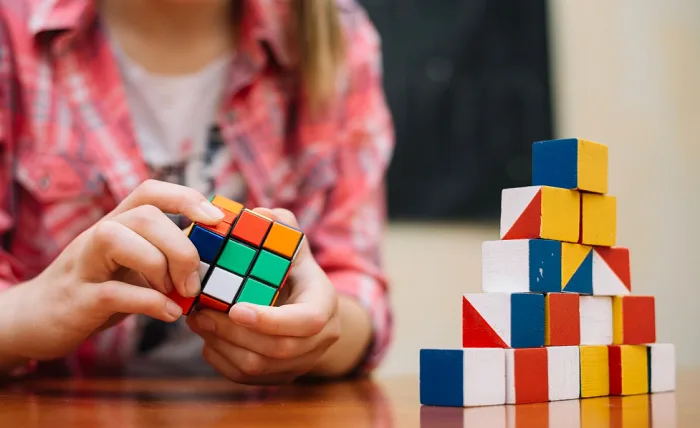If you’ve ever been intrigued by twisty puzzles, you’ve likely encountered the Pyraminx and Rubik’s Cube, two iconic puzzles that have captured the fascination of millions worldwide. These puzzles offer a unique blend of challenge and entertainment, making them popular among puzzle enthusiasts. This article will delve into the world of Pyraminx and Rubik’s Cube, comparing their key attributes and shedding light on how to solve the Pyraminx.
Solving the Pyraminx
Solving the Pyraminx can be a rewarding experience, but it requires patience and practice. Beginners often start with the Keyhole method, which involves solving one layer of the puzzle first and then moving on to the rest. As you become more proficient, you can explore advanced methods like CFOP, which involves solving the Pyraminx in multiple steps, similar to how speedcubers tackle the Rubik’s Cube. Whichever method you choose, mastering the Pyraminx is a satisfying achievement.
Structure and Mechanism
The Pyraminx and Rubik’s Cube differ significantly in structure and mechanism. The Rubik’s Cube is a 3x3x3 cube with 54 stickers, while the Pyraminx is a tetrahedron with nine stickers per face. These structural differences profoundly impact how the puzzles operate and how they are manipulated during solving.
The Rubik’s Cube employs a complex layer-turning mechanism, allowing for extensive shuffling and mixing of the stickers. You can independently rotate each of its six faces, creating many possible combinations. In contrast, the Pyraminx has a simpler turning mechanism, with its four faces and limited range of movements. While the Rubik’s Cube relies on the concept of layers and centers, Pyraminx’s design involves rotating the triangular tips to align the colors.
Understanding the structure and mechanism of each puzzle is crucial for solving them effectively. The Rubik’s Cube’s intricate layer system requires a deep understanding of algorithms and strategies, while the Pyraminx’s unique shape demands a different set of solving techniques.
Difficulty Level
Regarding difficulty, the Rubik’s Cube is often considered more challenging than the Pyraminx. The sheer number of combinations on a 3x3x3 Rubik’s Cube can be overwhelming, requiring advanced solving techniques. Solving the Rubik’s Cube involves concepts like edge pairing, corner orientation, and solving multiple layers simultaneously. It’s a puzzle that can take considerable time and practice to master.
On the other hand, the Pyraminx’s limited moves make it more accessible to beginners. The simplified structure means fewer possible combinations, making it easier to wrap your head around solving strategies. However, don’t be fooled – mastering the Pyraminx can still be formidable, especially when you aim for faster solve times. Achieving speedcubing records with Pyraminx requires precision and efficiency in your problem-solving methods.
Variations and Sizes
The Pyraminx and Rubik’s Cube have spawned various sizes and variations, catering to various preferences and skill levels. While the standard 3x3x3 Rubik’s Cube and regular Pyraminx are the most popular, exploring different sizes and variants can add a new dimension to your puzzle-solving journey.
In addition to the standard 3x3x3 Rubik’s Cube, you can find smaller versions like the 2x2x2 Pocket Cube, an excellent entry point for beginners. For those seeking an even greater challenge, there are larger cubes, such as the 4x4x4 and 5x5x5, which introduce additional layers and complexities. These larger cubes require advanced solving techniques, including edge pairing and algorithms specific to their dimensions.
Similarly, the Pyraminx offers variations like the Pyraminx Duo and the Pyraminx Crystal. The Pyraminx Duo simplifies the puzzle by reducing the number of stickers and faces, making it suitable for young enthusiasts. The Pyraminx Crystal, on the other hand, adds complexity with its crystal-shaped design, requiring a different approach to solving.
Exploring these variations and sizes allows puzzle enthusiasts to tailor their experience to their skill level and preferences. Whether you prefer the classic 3x3x3 Rubik’s Cube or enjoy the challenge of larger cubes and unique shapes, there’s a puzzle variant for everyone.
Solver’s Community
Both the Pyraminx and Rubik’s Cube have vibrant solver communities that span the globe. Enthusiasts of all ages and skill levels come together to share their passion for twisty puzzles, exchange solving tips, and participate in competitive events. Speedcubing, the practice of solving these puzzles as quickly as possible, has gained immense popularity within these communities, leading to organized competitions and world records.
Educational Benefits
Puzzles like the Pyraminx and Rubik’s Cube offer more than just entertainment; they also provide valuable educational benefits. Solving these puzzles enhances critical thinking, problem-solving, and spatial reasoning skills. They require you to think logically, plan your moves, and adapt to changing situations – skills with real-world applications in various fields.
Conclusion
In conclusion, the Pyraminx and Rubik’s Cube are two captivating puzzles with unique characteristics and challenges. Learning how to solve the Pyraminx opens up a world of pyramid-shaped fun, while the Rubik’s Cube offers a more complex and intricate puzzle-solving experience. Both puzzles have their merits and are sure to provide hours of enjoyment and mental stimulation. Whether you choose the Pyraminx or the Rubik’s Cube, you embark on a rewarding journey into twisty puzzles.



